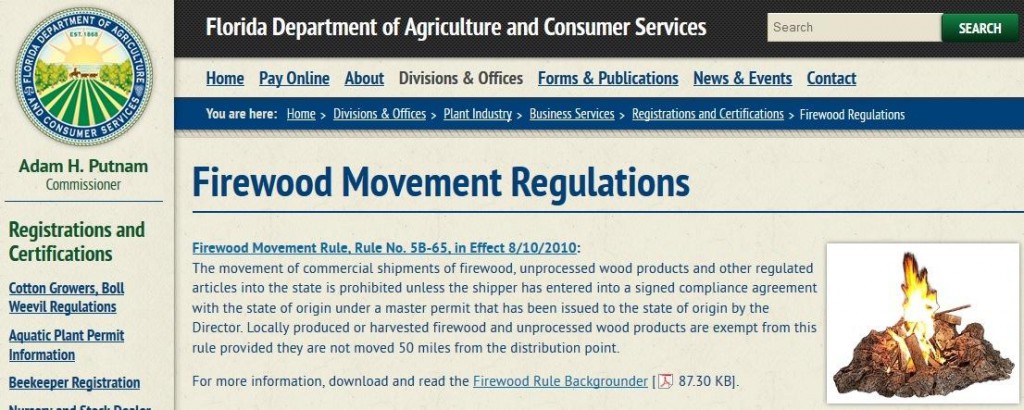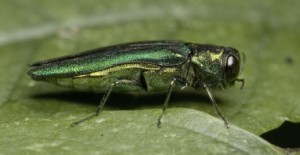
The emerald ash borer (EAB), Agrilus planipennis Fairmaire (Coleoptera: Buprestidae) is an invasive wood-boring beetle of regulatory significance that is native to China and East Asia. The EAB was discovered in southeastern Michigan in the summer of 2002 and most likely arrived in the U.S. in solid wood packing material carried in cargo. It has spread to several surrounding states, where it has killed tens of millions of ash trees. Adult beetles chew on ash foliage, but cause little damage. Larvae feed on the inner bark of ash trees, disrupting the tree’s ability to transport water and nutrients. Infested trees initially show canopy dieback. Extensive larval damage can lead to tree death. Effective May 1, 2015, the Animal and Plant Health Inspection Service (APHIS) added all of New York to the list of regulated areas for the EAB in response to the detections of EAB. Any suspect samples detected in Florida will need to be confirmed by a specialist. Samples can be submitted to the UF Insect Identification Laboratory (http://entnemdept.ufl.edu/insectid/index.html ) or directly to FDACS-DPI (http://www.freshfromflorida.com/Divisions-Offices/Plant-Industry ).
The emerald ash borer has been detected in Georgia but not in Florida. We are currently surveying ash in Florida.
– The Cooperative Agricultural Pest Survey Program State Survey Coordinator: Dr. Leroy Whilby
Control of any wood-boring insect, once established, is very difficult. The best cure is prevention. Firewood may contain insect pests and plant diseases that could easily spread to other locations. Moving firewood, nursery stock, and other ash wood materials in areas infested with emerald ash borer is regulated by the infested states and federal government. Please click on the image below to review firewood movement regulations for Florida.
Identification: Adult EAB (Fig. 1) have a narrow body approximately 1/2 inch (7.5-13.5 mm) in length with a flat back and are bright green above with a purple abdomen under the wing covers. When disturbed adults fly readily to avoid capture and are often difficult to observe. In the Southeast, adult EAB differ from native metallic wood borers by their large size, narrow body, and bright green coloration. Larvae (Fig. 2) are flat-headed wood borers that can be found in serpentine galleries under the bark. These larvae are cream colored and flat.
Hosts: Only ash trees (Fraxinus spp.), showing a preference for the green and black ash. There are four species of ash in Florida; white ash (Fraxinus americana L.), pop ash (Fraxinus caroliniana Mill.), green ash (Fraxinus pennsylvanica Marshall), and pumpkin ash (Fraxinus profunda (Bush)), which primarily occur throughout the northern half of the state. All Florida ash species are potential hosts for EAB.
Survey: For larvae, look for trees with signs of decline and canopy dieback. On trees with those symptoms, look for split bark (Fig. 3), serpentine larval galleries (Fig. 4), and D-shaped exit holes (Fig. 5). Look for larvae under the bark in the galleries. The life cycle of EAB is generally one year. In all cases, specimens are needed for confirmation of the presence of EAB. Official surveys of EAB often involve the use of purple traps (Fig. 6) hung in ash trees. If you see one of these traps please do not disturb it.
Florida First Detector offers a scripted presentation specific to EAB. The National Plant Diagnostic Network (NPDN) has an online national module for EAB on the NPDN Training Site at: https://firstdetector.org/
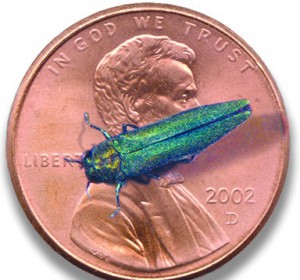

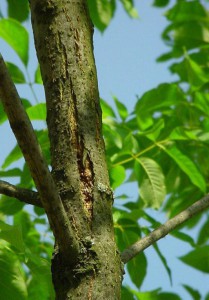
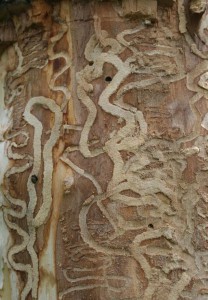


References:
Skelley, Paul E. and Thomas, Michael C., Emerald Ash Borer, Agrilus Planipennis Fairmaire (Coleoptera: Buprestidae). 2013. Florida Department of Agriculture and Consumer Services.
NSF Center for Integrated Pest Management, 04/29/2015. Agrilus planipennis (Emerald Ash Borer) – Updated regulated areas in the United States North American Plant Protection Phytosanitary Alert System.
 0
0
